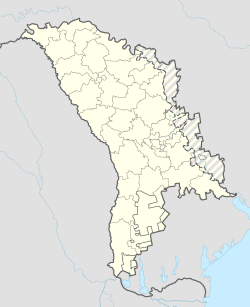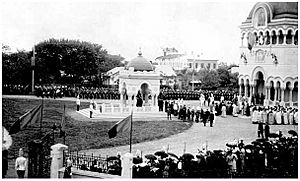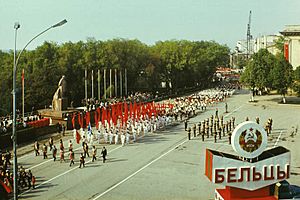Bălți facts for kids
Quick facts for kids
Bălți
|
|||
|---|---|---|---|
|
|
|||
|
|||
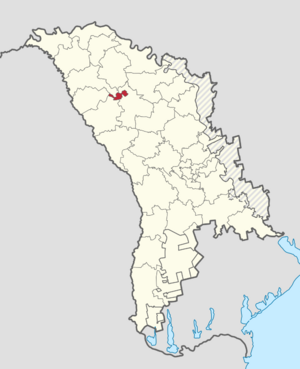
Bălți highlighted red in Moldova
|
|||
| Country | |||
| Communes | Sadovoe, Elizaveta | ||
| Founded | 1620 | ||
| City rights | 1803 | ||
| Government | |||
| • Type | Mayor–council government | ||
| Area | |||
| • Total | 78.00 km2 (30.12 sq mi) | ||
| Elevation | 59 m (194 ft) | ||
| Population
(2014 census)
|
|||
| • Total | 102,457 | ||
| • Estimate
(1 January 2019)
|
146,900 | ||
| • Density | 1,346/km2 (3,490/sq mi) | ||
| Time zone | UTC+2 (EET) | ||
| • Summer (DST) | UTC+3 (EEST) | ||
| Postal code |
MD-3100
|
||
| Area code(s) | +373 231 X-XX-XX | ||
| Licence plate | BL XX 000 | ||
Bălți is a city in Moldova. It's the second-largest city in the country. This means it has the second-biggest population, area, and is very important for the economy, right after Chișinău, the capital. Bălți is sometimes called "the northern capital" because it's a big center for industry, culture, business, and transportation in the north of Moldova. It is located about 127 kilometres (79 mi) north of Chișinău. The city sits on the Răut River, which flows into the Dniester River. It's built on hills in an area called the Bălți Steppe.
Contents
What does the name Bălți mean?
The word "bălți" comes from the Romanian language. It means "puddle" or "wetlands." People believe the city got its name because it was built on a hill overlooking a wet area. This wet area was formed where a small creek, Răuțel, joins the Răut River.
City Symbols: Coat of Arms and Flag
What is the Coat of Arms of Bălți?
The current coat of arms and flag of Bălți were chosen in April 2006. They were designed by Silviu Tabac.
The coat of arms has a shield with six silver stripes and six blue stripes. These stripes represent water and earth, which relates to the city's name meaning "puddle." In the middle of the shield, there's an archer in red clothes. The archer wears a yellow military outfit from the 15th century, like those worn during the time of Stephen III of Moldavia. This archer stands for the local free farmers who joined the army back then.
Above the shield, there's a silver crown shaped like a fortress wall with seven towers. This crown shows that Bălți is a city. Only Bălți, the capital Chișinău, and Tiraspol are allowed to have seven towers on their crowns. Other cities have fewer. Two silver horses support the shield. A white horse is a traditional symbol of this region. Below the shield, a ribbon has a Latin saying: CEDANT ARMA TOGAE. This means "let arms yield to the toga" (meaning, let military power give way to civilian rule or peace).
In the past, the archer was also on the coats of arms of this region. In the 19th century, a horse head was also used.
What does the Flag of Bălți look like?
The city's flag has two horizontal stripes. The bottom stripe is blue, and the top stripe is silver. The shield and archer from the coat of arms are also in the middle of the flag.
Geography and Nature
Bălți is built on the tops and sides of three hills, and in two small valleys. The land in northern Moldova is very rich and fertile. It mostly has black earth, which is great for farming. There are also places nearby where materials for building, like stone, can be found.
Small creeks like Răuțel, Copăceanca, and Flămândă flow through the city and into the Răut River. Bălți also has several lakes, including City Lake, Komsolskoe Lake, Hunters and Fishermen Lake, and Strâmba Lake.
The whole area of the city, called the municipality, covers about 78.0 square kilometres (30.1 sq mi). The city itself is 41.42 square kilometres (15.99 sq mi). The nearby villages of Elizaveta (to the east) and Sadovoe (to the northwest) are also part of the municipality. A large part of this land, about 20.11 square kilometres (7.76 sq mi), is used for farming.
City Neighbourhoods
The city is spread across parts of three hills. The Răut River separates one hill to the northeast, where the Slobozia neighborhood is located. The Răuțel creek separates another hill to the south, which is home to Podul Chișinăului.
The largest hill holds the city center, the old town, and neighborhoods like Pământeni, Dacia, 6th district, 8th district, and Molodova. This hill also has the city's main industrial area. The medical facilities are at the top of this hill. The Bălții Noi neighborhood is in the valley of the Răuțel creek.
Other neighborhoods include Soroca, 10th district, and 9th district. The Bălți City Airport is in the valley of the Răut River. Many neighborhood names come from old suburbs or from the Soviet era.
Climate in Bălți
Bălți has a climate with warm summers. The highest temperature ever recorded was 38 °C (100 °F), and the lowest was −32 °C (−26 °F). The city gets about 450 to 550 mm (18 to 22 in) of rain each year, mostly in summer and fall. Winds usually come from the northeast or northwest.
| Climate data for Bălți (1991–2020) | |||||||||||||
|---|---|---|---|---|---|---|---|---|---|---|---|---|---|
| Month | Jan | Feb | Mar | Apr | May | Jun | Jul | Aug | Sep | Oct | Nov | Dec | Year |
| Mean daily maximum °C (°F) | 0.9 (33.6) |
3.3 (37.9) |
9.5 (49.1) |
17.1 (62.8) |
23.3 (73.9) |
26.7 (80.1) |
28.7 (83.7) |
28.5 (83.3) |
22.6 (72.7) |
15.7 (60.3) |
8.3 (46.9) |
2.4 (36.3) |
15.6 (60.1) |
| Daily mean °C (°F) | −2.3 (27.9) |
−0.7 (30.7) |
4.1 (39.4) |
10.7 (51.3) |
16.4 (61.5) |
20.2 (68.4) |
22.0 (71.6) |
21.4 (70.5) |
16.0 (60.8) |
9.9 (49.8) |
4.3 (39.7) |
−0.8 (30.6) |
10.1 (50.2) |
| Mean daily minimum °C (°F) | −5.5 (22.1) |
−4.2 (24.4) |
−0.5 (31.1) |
4.8 (40.6) |
10.1 (50.2) |
14.1 (57.4) |
15.8 (60.4) |
15.0 (59.0) |
10.4 (50.7) |
5.1 (41.2) |
1.0 (33.8) |
−3.9 (25.0) |
5.2 (41.4) |
| Average precipitation mm (inches) | 25 (1.0) |
24 (0.9) |
28 (1.1) |
35 (1.4) |
49 (1.9) |
68 (2.7) |
68 (2.7) |
48 (1.9) |
48 (1.9) |
36 (1.4) |
32 (1.3) |
28 (1.1) |
489 (19.3) |
| Average precipitation days (≥ 1.0 mm) | 6 | 5 | 6 | 6 | 8 | 8 | 8 | 6 | 6 | 5 | 5 | 6 | 74 |
| Mean monthly sunshine hours | 59 | 87 | 151 | 204 | 254 | 266 | 282 | 278 | 209 | 144 | 73 | 56 | 2,058 |
| Source: NOAA | |||||||||||||
People and Culture
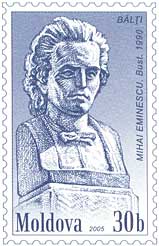
How many people live in Bălți?
In 2014, about 102,457 people lived in the Bălți municipality. This was a bit less than in 2004. Most people live in the city itself (97,930), with others in the nearby villages of Elizaveta and Sadovoe. There were more women (55,527) than men (46,930).
Ethnic composition of Bălți (2014) Moldovans* (60.55%) Romanians (2.89%) Ukrainians (18.48%) Russians (16.04%) Others (2.03%)
Footnotes: * There is an ongoing discussion about whether people identify as Moldovans or Romanians. * In March 2023, the Parliament of Moldova decided that the national language should be called Romanian in all official documents.
What religions are practiced in Bălți?
Most people in Bălți are Christian Orthodox (about 90.7%). Other religions include Baptist (2.1%), Catholic (0.8%), and smaller groups like Seventh-day Adventists, Pentecostals, and Muslims. A small number of people identify as atheist or non-religious.
What languages do people speak in Bălți?
Most people in Bălți can speak both Romanian and Russian. Some people only know one of these languages. Many also understand or speak Ukrainian.
What is the culture like in Bălți?
Bălți has many places for culture and entertainment:
- Vasile Alecsandri National Theatre
- "Eugène Ionesco" Theatre
- "Licurici" Republican Puppet Theatre
- "B.P. Hajdeu" Republican Drama-Muzical Theatre
- "Mihai Eminescu" National Theatre
- "Luceafarul" Republican Theatre
- Municipal Theatre "Satiricus I.L. Caragiale"
You can also visit:
- "Exhibition of the Union of painters "Constantin Brâncuși"
- Artum Art Gallery
What churches are in Bălți?
Bălți has many beautiful churches:
- Saint Nicolas Church, Bălți (1795)
- Saint Constantine and Elena Cathedral, Bălți (1934), built in a special style called neo-Byzantine. The Romanian royal family was at its opening.
- Bishopric Palace, Bălți (1924–1932)
- Saint Parascheva Church, Bălți (1933)
- Archangels Michael and Gabriel Church, Bălți (1912–1933)
- Saint Peter and Paul Church, Bălți (1915–1929)
- Armenian Saint Gregory Church, Bălți (1916)
- Birth of the Blessed Virgin Mary Church (1884)
What about media in Bălți?
Bălți has several news sources:
- Deca-press, the oldest independent news agency in northern Moldova.
- Spros i Predlojenie, a major Russian language newspaper.
- Gazeta.MD a news agency.
- Golos Bălți, the city newspaper.
- Makler, an advertising newspaper.
There are also many FM radio stations, playing different types of music and news.
What sports can you do in Bălți?
Bălți has 7 sports schools that offer programs in many sports, including:
- Orienteering
- Volleyball
- Handgun shooting
- Equestrianism (horse riding)
- Basketball
- Handball
- Weightlifting
- Chess
- Swimming
- Canoeing
- Football
- Athletics
- Tourism (hiking and outdoor activities)
The city also has the Municipal Stadium "Olimpia Bălți Stadium", which is home to the FC Olimpia Bălți football club. There are two Olympic swimming pools: "Central" and "Volna" (which is outdoors).
Economy and Jobs
Bălți has always been known for its tobacco production, vineyards, and orchards. Today, much of the city's industry focuses on food processing. This includes making flour, sugar, and wine. Making furniture and farm machines are also important jobs in Bălți.
After 1989, the service sector grew to meet the needs of the people. This includes things like shops, restaurants, and other services.
What is made in Bălți?
Bălți is an important economic center. Besides traditional Moldovan products like wine, sugar, meat, and flour, the city also makes agricultural machinery, construction materials, fur, textiles, and furniture.
In the past, a very large factory called "Răut" (formerly "Lenin") employed 8,000 workers. It made many different machine parts, from irons and telephones to special equipment for Soviet military submarines. After the Soviet system ended, the factories faced challenges. However, new businesses are now working with companies from the European Union, bringing new jobs and investments. For example, Lisa Dräxlmaier GmbH opened a large factory in Bălți that makes wiring for cars.
Where can you shop in Bălți?
Bălți has several large shopping centers and supermarkets. You can find shops in the city center, and in the Dacia district. The central market opens early in the morning. There are also many small private stores.
Education and Learning
Schools in Bălți
Bălți has 13 high schools (called lyceums) and 6 professional schools. These schools offer the last few years of high school and two years of technical training after high school. There are also 14 secondary schools and 7 professional-technical schools. The city has 3 boarding schools, including one for students who are visually impaired.
Universities in Bălți
- The Alecu Russo University of Bălți is the second-largest university in Moldova. It's named after a famous Romanian scholar. The university has one of the biggest libraries in South-Eastern Europe.
- There are also private universities like the Dniester Institute of Economy and Law.
These schools teach in Romanian, Russian, Ukrainian, or English. Some schools use a mix of languages, a system that came from the Soviet era.
Historical Buildings and Monuments
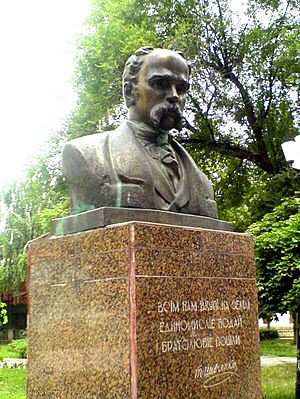
Bălți has many important historical buildings and monuments:
- Saint Nicolas Cathedral (1795)
- Church of the Nativity of the Virgin Mary (1884)
- Saint Gregory Armenian Church (1916)
- Saint Constantine and Helen Cathedral (1935)
- Saint Parascheva Church (1934)
- Church of the Holy Apostles Peter and Paul (1929)
- Church of the Holy Archangels Michael and Gabriel (1933)
- Bălți Bishopric (1934)
- Vasile Alecsandri National Theatre
- Matrimonial Palace
- History and Ethnography Museum
- A monument of Stefan the Great (2003)
- Bust of Mihai Eminescu
- Bust of Vasile Alecsandri
- Bust of Taras Shevchenko (2001)
- A monument to soldiers who died in Afghanistan (1999)
- Bust of King Ferdinand I of Romania at the University of Bălți (2023)
Getting Around Bălți
Public Transport
Getting around Bălți is mostly done by trolleybuses, buses, minibuses, and taxis. In 2004, over 35 million passengers used public transport!
There are about 25 minibus lines in Bălți. The Bălți Bus Authority runs regular bus routes mainly in the suburbs. Private companies also offer bus and minibus services within the city.
Bălți has 3 trolleybus lines, with a fourth one planned. Most trolleybuses are older Soviet models, but there are also newer ones from Belarus and Russia.
| Line | Length | In service from | Number of stations | Number of cars on route | Serviced by | Notes | |
|---|---|---|---|---|---|---|---|
| 1 | Quarter "Molodova" – Airport Bălți-Oraș | 16.8 km (10.44 mi) | 1972 | 20 | 4 | B.T.A. | |
| 2 | North train station – Quarter "Dacia" | 17.0 km (10.56 mi) | 1972 | 30 | 16 | B.T.A. | |
| 3 | SA "Basarabia Nord" – Bus station | 14.0 km (8.70 mi) | 1972? | 14 | 8 | B.T.A. | |
| 4 | Center – Quarter "Dacia" | B.T.A. | Closed | ||||
| 5 | Center – Airport Bălți-Oraș | B.T.A. | Closed | ||||
You can also find many taxi services in Bălți. Most taxis charge a set fee for rides within the city.
Road Travel
Bălți is an important place for transportation in Moldova. You can travel between cities by coach or van. A 135 kilometres (84 miles) highway connects Bălți to the capital, Chișinău. You can also reach Ukraine (about 2 hours away) and Romania (about 1 hour away) by road.
The Bălți Inter-City Coach Station offers regular bus connections all over Moldova, and even to other countries in Europe.
Train Travel
There are regular train connections from Bălți to other cities like Ocnița, Rezina, Ungheni, and Chișinău. However, a trip to Chișinău (about 200 kilometres (124 miles)) can take 6 hours because the railway lines are not electrified and only have one track between stations. The national company, Calea Ferată din Moldova, is in charge of the railways.
Bălți has two railway stations: Bălți-City Station and Bălți-Slobozia Station. Both handle trains for travel within Moldova and to other countries.
Air Travel
Bălți has two airports. One is Bălți International Airport, located about 15 kilometres (9 miles) north of the city. It was built in the 1980s and can handle large planes. It's used for charter flights (special flights, not regular ones) for passengers and cargo.
The second airport, Bălți City Airport, is on the eastern edge of the city. It's used for smaller planes, city services, agriculture, emergencies, and pilot training.
Famous People from Bălți
Many notable people have come from Bălți, including:
- Boris Anisfeld, a painter and theater designer.
- Mihai Volontir, a famous Moldovan actor.
- Natalia Barbu, a singer who represented Moldova in the Eurovision Song Contest in 2007.
- Gheorghe Briceag, a human rights activist.
- Eugenio Coșeriu, a famous language expert.
- Marian Lupu, a politician who was the speaker of the Parliament of Moldova.
- Vadim Vacarciuc, a weightlifter and 1997 World Champion.
- Isa Kremer, a famous singer.
Fun Fact
The famous Yiddish song Mein Shtetle Belz from 1932 is about the old Jewish city of Bălți. It was a tribute to the singer Isa Kremer, who was born in Bălți and was likely the first to perform it.
International Connections
Twin Towns and Sister Cities
Bălți is connected with many cities around the world as "twin towns" or "sister cities." This means they have special friendships and often share cultural events or projects.
 Arad, Israel
Arad, Israel Białystok, Poland
Białystok, Poland Botoșani, Romania
Botoșani, Romania Chernivtsi, Ukraine
Chernivtsi, Ukraine Comrat, Moldova
Comrat, Moldova Gyula, Hungary
Gyula, Hungary İzmir, Turkey
İzmir, Turkey Jining, China
Jining, China Khmelnytskyi, Ukraine
Khmelnytskyi, Ukraine Lakeland, United States
Lakeland, United States Larissa, Greece
Larissa, Greece Livny, Russia
Livny, Russia Miercurea Ciuc, Romania
Miercurea Ciuc, Romania Mohyliv-Podilskyi, Ukraine
Mohyliv-Podilskyi, Ukraine Narva, Estonia
Narva, Estonia Nizhny Novgorod, Russia
Nizhny Novgorod, Russia Orsha, Belarus
Orsha, Belarus Płock, Poland
Płock, Poland Podolsk, Russia
Podolsk, Russia Polotsk, Belarus
Polotsk, Belarus Pushkin (Saint Petersburg), Russia
Pushkin (Saint Petersburg), Russia Rechytsa, Belarus
Rechytsa, Belarus Smolyan, Bulgaria
Smolyan, Bulgaria Stryi, Ukraine
Stryi, Ukraine Suceava, Romania
Suceava, Romania Vinnytsia, Ukraine
Vinnytsia, Ukraine Vitebsk, Belarus
Vitebsk, Belarus Western Administrative Okrug (Moscow), Russia
Western Administrative Okrug (Moscow), Russia Wuzhong, China
Wuzhong, China Zapadnoye Degunino District (Moscow), Russia
Zapadnoye Degunino District (Moscow), Russia
Consulates in Bălți
A consulate is like a small embassy that helps citizens from its country who are living or traveling in Bălți.
 Consulate-General of Romania, address: 51, Sfântul Nicolae Str.
Consulate-General of Romania, address: 51, Sfântul Nicolae Str. Consulate of Ukraine, address: 143, Kiev Str.
Consulate of Ukraine, address: 143, Kiev Str.
See also
 In Spanish: Bălți para niños
In Spanish: Bălți para niños











